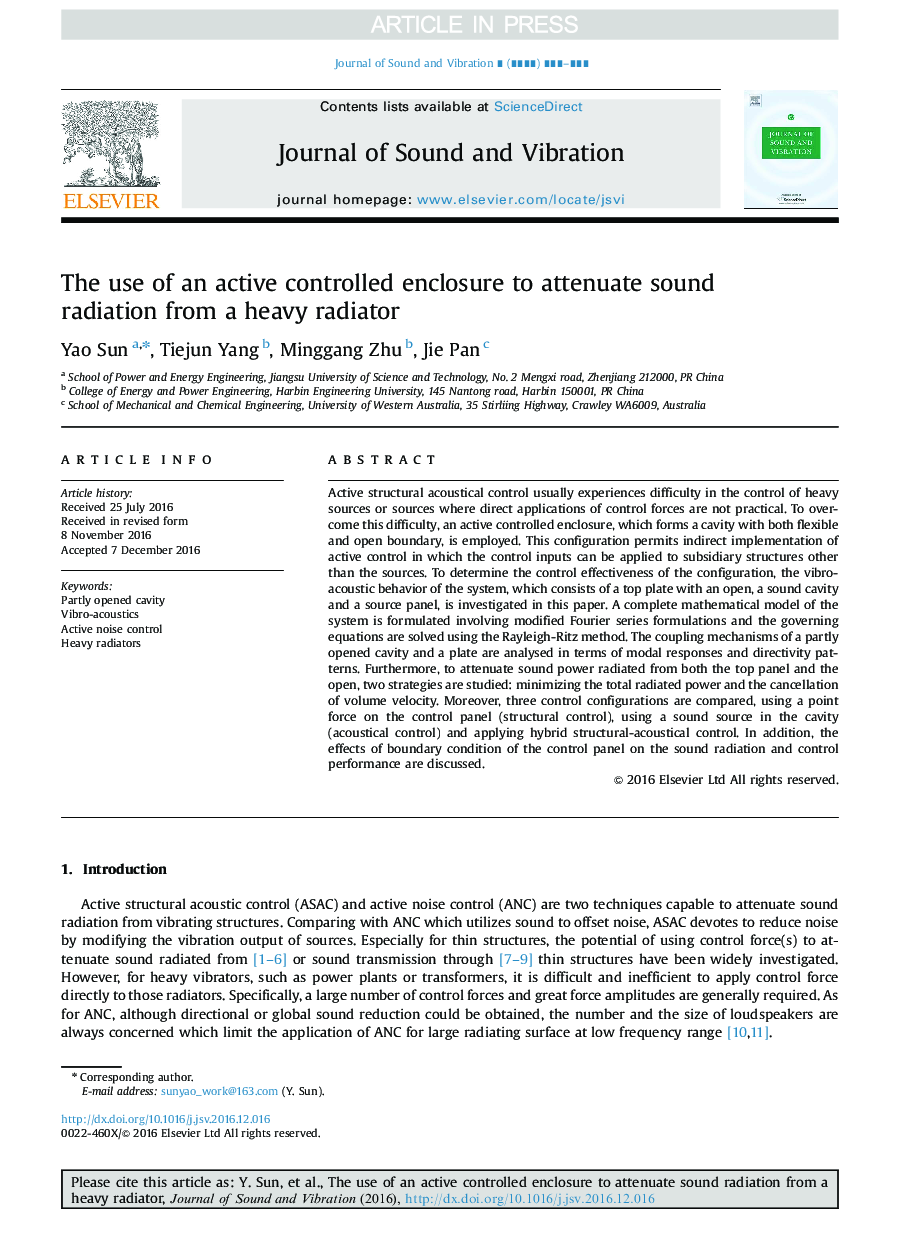| کد مقاله | کد نشریه | سال انتشار | مقاله انگلیسی | نسخه تمام متن |
|---|---|---|---|---|
| 4924356 | 1430841 | 2017 | 17 صفحه PDF | دانلود رایگان |
عنوان انگلیسی مقاله ISI
The use of an active controlled enclosure to attenuate sound radiation from a heavy radiator
ترجمه فارسی عنوان
استفاده از محفظه کنترل فعال برای تضعیف تابش صدا از رادیاتور سنگین
دانلود مقاله + سفارش ترجمه
دانلود مقاله ISI انگلیسی
رایگان برای ایرانیان
کلمات کلیدی
حفره به طور جزئی باز شده است ویبره آکوستیک، کنترل نویز فعال، رادیاتورهای سنگین
ترجمه چکیده
کنترل آکوستیک ساختاری فعال معمولا در کنترل منابع و منابع سنگین مشکلاتی را به وجود می آورد که در آن کاربرد مستقیم نیروهای کنترل عملی نیست. برای غلبه بر این مشکل، یک محفظه کنترل فعال، که یک حفره با هر دو مرز انعطاف پذیر و باز را تشکیل می دهد، مورد استفاده قرار می گیرد. این پیکربندی امکان اجرای غیرمستقیم کنترل فعال را فراهم می کند که در آن ورودی های کنترل می توانند به ساختارهای فرعی دیگری غیر از منابع اعمال شوند. برای تعیین تأثیر کنترل از پیکربندی، رفتار ارتعاشی آکوستیک سیستم، که شامل یک صفحه بالا با یک باز، یک حفره صوتی و یک پانل منبع است، در این مقاله مورد بررسی قرار گرفته است. یک مدل ریاضی کامل از سیستم با استفاده از فرمولهای سری فوریه تعدیل شده و معادلات حاکم با استفاده از روش ریلیز ریتز حل می شود. مکانیسم های اتصال از حفره ای که به تازگی باز شده است و یک صفحه با توجه به پاسخ های مدال و الگوهای هدایت آن تحلیل می شود. علاوه بر این، برای کاهش قدرت صدا که از هر دو پانل بالا و باز باز می شود، دو استراتژی مورد مطالعه قرار می گیرند: به حداقل رساندن کل نیروی شعاعی و کاهش سرعت حجم. علاوه بر این، سه پیکربندی کنترل با استفاده از یک نیروی نقطه در کنترل پنل (کنترل ساختاری)، با استفاده از یک منبع صوتی در حفره (کنترل صدا) و استفاده از کنترل هیبرید ساختاری-آکوستیک مقایسه می شود. علاوه بر این، اثرات شرایط مرزی کنترل پنل بر روی تابش صدا و عملکرد کنترل مورد بحث قرار می گیرد.
موضوعات مرتبط
مهندسی و علوم پایه
سایر رشته های مهندسی
مهندسی عمران و سازه
چکیده انگلیسی
Active structural acoustical control usually experiences difficulty in the control of heavy sources or sources where direct applications of control forces are not practical. To overcome this difficulty, an active controlled enclosure, which forms a cavity with both flexible and open boundary, is employed. This configuration permits indirect implementation of active control in which the control inputs can be applied to subsidiary structures other than the sources. To determine the control effectiveness of the configuration, the vibro-acoustic behavior of the system, which consists of a top plate with an open, a sound cavity and a source panel, is investigated in this paper. A complete mathematical model of the system is formulated involving modified Fourier series formulations and the governing equations are solved using the Rayleigh-Ritz method. The coupling mechanisms of a partly opened cavity and a plate are analysed in terms of modal responses and directivity patterns. Furthermore, to attenuate sound power radiated from both the top panel and the open, two strategies are studied: minimizing the total radiated power and the cancellation of volume velocity. Moreover, three control configurations are compared, using a point force on the control panel (structural control), using a sound source in the cavity (acoustical control) and applying hybrid structural-acoustical control. In addition, the effects of boundary condition of the control panel on the sound radiation and control performance are discussed.
ناشر
Database: Elsevier - ScienceDirect (ساینس دایرکت)
Journal: Journal of Sound and Vibration - Volume 392, 31 March 2017, Pages 1-17
Journal: Journal of Sound and Vibration - Volume 392, 31 March 2017, Pages 1-17
نویسندگان
Yao Sun, Tiejun Yang, Minggang Zhu, Jie Pan,
